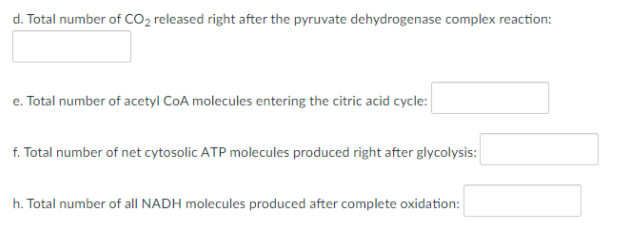d. Total number of CO2 released right after the pyruvate dehydrogenase complex reaction: e. Total number of acetyl CoA molecules entering the citric acid cycle:| f. Total number of net cytosolic ATP molecules produced right after glycolysis:
d. Total number of CO2 released right after the pyruvate dehydrogenase complex reaction: e. Total number of acetyl CoA molecules entering the citric acid cycle:| f. Total number of net cytosolic ATP molecules produced right after glycolysis:
Biochemistry
9th Edition
ISBN:9781319114671
Author:Lubert Stryer, Jeremy M. Berg, John L. Tymoczko, Gregory J. Gatto Jr.
Publisher:Lubert Stryer, Jeremy M. Berg, John L. Tymoczko, Gregory J. Gatto Jr.
Chapter1: Biochemistry: An Evolving Science
Section: Chapter Questions
Problem 1P
Related questions
Question
please answer all

Transcribed Image Text:Upon digestion of starch, maltose, one of its degradation products, is further hydrolyzed into its
monosaccharide components prior to intestinal absorption and entry into the glycolysis. Calculate the
number of ATP molecules produced from the digestion and complete oxidation of 1 molecule of maltose
considering the glycerol 3-phosphate shuttle. Answer the following items using numerical value only (e.g. 1
not "1 ATP") which will help you arrive at the final answer for this question.

Transcribed Image Text:d. Total number of CO2 released right after the pyruvate dehydrogenase complex reaction:
e. Total number of acetyl CoA molecules entering the citric acid cycle:
f. Total number of net cytosolic ATP molecules produced right after glycolysis:
h. Total number of all NADH molecules produced after complete oxidation:
Expert Solution
This question has been solved!
Explore an expertly crafted, step-by-step solution for a thorough understanding of key concepts.
Step by step
Solved in 3 steps

Recommended textbooks for you

Biochemistry
Biochemistry
ISBN:
9781319114671
Author:
Lubert Stryer, Jeremy M. Berg, John L. Tymoczko, Gregory J. Gatto Jr.
Publisher:
W. H. Freeman

Lehninger Principles of Biochemistry
Biochemistry
ISBN:
9781464126116
Author:
David L. Nelson, Michael M. Cox
Publisher:
W. H. Freeman

Fundamentals of Biochemistry: Life at the Molecul…
Biochemistry
ISBN:
9781118918401
Author:
Donald Voet, Judith G. Voet, Charlotte W. Pratt
Publisher:
WILEY

Biochemistry
Biochemistry
ISBN:
9781319114671
Author:
Lubert Stryer, Jeremy M. Berg, John L. Tymoczko, Gregory J. Gatto Jr.
Publisher:
W. H. Freeman

Lehninger Principles of Biochemistry
Biochemistry
ISBN:
9781464126116
Author:
David L. Nelson, Michael M. Cox
Publisher:
W. H. Freeman

Fundamentals of Biochemistry: Life at the Molecul…
Biochemistry
ISBN:
9781118918401
Author:
Donald Voet, Judith G. Voet, Charlotte W. Pratt
Publisher:
WILEY

Biochemistry
Biochemistry
ISBN:
9781305961135
Author:
Mary K. Campbell, Shawn O. Farrell, Owen M. McDougal
Publisher:
Cengage Learning

Biochemistry
Biochemistry
ISBN:
9781305577206
Author:
Reginald H. Garrett, Charles M. Grisham
Publisher:
Cengage Learning

Fundamentals of General, Organic, and Biological …
Biochemistry
ISBN:
9780134015187
Author:
John E. McMurry, David S. Ballantine, Carl A. Hoeger, Virginia E. Peterson
Publisher:
PEARSON